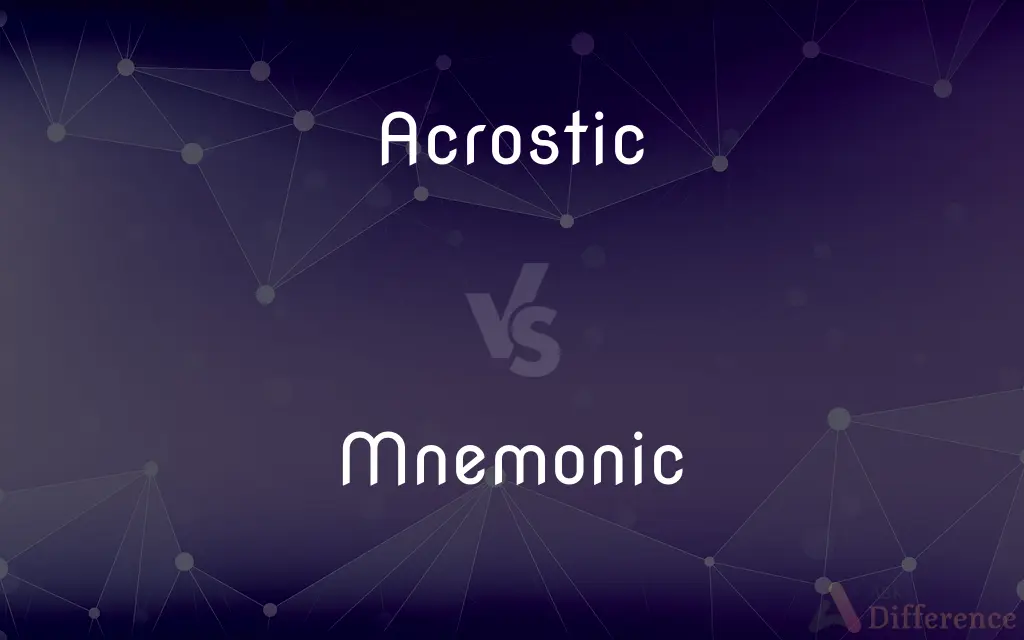Acrostic vs. Mnemonic — What's the Difference?
By Urooj Arif & Maham Liaqat — Updated on April 22, 2024
Acrostics are poems where specific letters form a word or message, whereas mnemonics are memory aids using associations like phrases or rhymes.

Difference Between Acrostic and Mnemonic
Table of Contents
ADVERTISEMENT
Key Differences
Acrostics are structured such that the first, last, or other specific letters in each line spell out a word or phrase when read vertically. This technique is often used in poetry or as a creative form of expression. On the other hand, mnemonics are tools designed to help remember information, utilizing systems like acronyms, rhymes, or songs to encode data in a more memorable format.
In education, acrostics might be used to engage students in language arts by having them create poems that highlight vocabulary words or concepts. Whereas, mnemonics are commonly employed across various subjects to aid in memorizing formulas, lists, or rules, enhancing recall through simple and effective memory triggers.
Acrostic poems can vary in complexity and are sometimes used as puzzles, where the deciphering of the vertical word or phrase adds an element of challenge or hidden meaning. In contrast, mnemonics are typically straightforward and designed to reduce cognitive load, making them practical and accessible learning tools.
While acrostics primarily serve an artistic or literary purpose, mnemonics are more utilitarian, focusing on practical applications in learning and memory enhancement. This distinction highlights the differing objectives of each method in educational and creative contexts.
Acrostics offer a unique way to embed secret messages or display word play within a text, providing a dual layer of engagement for the reader or writer. Conversely, mnemonics often leverage familiar or humorous imagery and language to create strong, lasting mental associations.
ADVERTISEMENT
Comparison Chart
Definition
A poem in which certain letters form a word.
A memory aid that uses associations.
Purpose
Artistic expression or puzzle.
Memory enhancement.
Usage in Text
First, last, or other letters in each line.
Often uses the first letters of words.
Complexity
Can vary from simple to complex.
Usually designed to be simple and memorable.
Primary Application
Poetry and creative writing.
Educational tools across various subjects.
Compare with Definitions
Acrostic
A type of puzzle where the vertical sequence of letters forms a hidden word or phrase.
Acrostic puzzles are popular in some literary magazines.
Mnemonic
A cognitive shortcut that aids in the storage and retrieval of information.
Historical dates are often memorized using mnemonics.
Acrostic
A creative tool used in classrooms to teach vocabulary and concepts.
Teachers use acrostic poems to make learning fun.
Mnemonic
A strategy that utilizes imagery, rhymes, or letters to enhance memory.
The mnemonic ROY G. BIV represents the colors of the rainbow.
Acrostic
An artistic technique in literature to convey hidden messages.
Medieval texts often contained acrostic signatures.
Mnemonic
A practical technique for remembering complex information.
Mnemonics help in mastering foreign language vocabulary.
Acrostic
A literary device that can embed subtext within text.
Some novelists use acrostics to add layers to their storytelling.
Mnemonic
A memory aid, typically a phrase or rhyme, that helps in remembering information.
My Very Educated Mother Just Served Us Nachos for the planets.
Acrostic
A poem or other form of writing in which the first letter of each line spells out a word or message.
Every Good Boy Does Fine can be an acrostic for learning musical notes.
Mnemonic
A tool used in education to facilitate learning and recall.
Mnemonics are essential for medical students memorizing vast amounts of information.
Acrostic
An acrostic is a poem (or other form of writing) in which the first letter (or syllable, or word) of each line (or paragraph, or other recurring feature in the text) spells out a word, message or the alphabet. The word comes from the French acrostiche from post-classical Latin acrostichis, from Koine Greek ἀκροστιχίς, from Ancient Greek ἄκρος "highest, topmost" and στίχος "verse".
Mnemonic
A mnemonic () device, or memory device, is any learning technique that aids information retention or retrieval (remembering) in the human memory. Mnemonics make use of elaborative encoding, retrieval cues, and imagery as specific tools to encode information in a way that allows for efficient storage and retrieval.
Acrostic
A poem, word puzzle, or other composition in which certain letters in each line form a word or words.
Mnemonic
A system such as a pattern of letters, ideas, or associations which assists in remembering something
The usual mnemonic for star types is O Be A Fine Girl Kiss Me
Acrostic
A poem or series of lines in which certain letters, usually the first in each line, form a name, motto, or message when read in sequence.
Mnemonic
Aiding or designed to aid the memory.
Acrostic
See word square.
Mnemonic
Relating to, assisting, or intended to assist the memory.
Acrostic
A word puzzle in which the answers to several different clues form an anagram of a quotation, phrase, or other text.
Mnemonic
A device, such as a formula or rhyme, used as an aid in remembering.
Acrostic
A poem or other text in which certain letters, often the first in each line, spell out a name or message.
Mnemonic
Especially of a series of ideas, letters, words, etc.: intended to help in remembering.
Acrostic
A poem in Hebrew in which successive lines or verses start with consecutive letters of the alphabet.
Mnemonic
Of or relating to study]] of techniques for remembering anything more easily.
Acrostic
A kind of word puzzle, the solution of which forms an anagram of a quotation, and their initials often form the name of its author.
Mnemonic
Of or relating to memory.
Acrostic
Of or pertaining to acrostics.
Mnemonic
Something (especially a series of ideas, letters, words, etc.) used to help in remembering a thing; a memory aid.
Acrostic
A composition, usually in verse, in which the first or the last letters of the lines, or certain other letters, taken in order, form a name, word, phrase, or motto.
Mnemonic
(computing) The human-readable, textual form of an assembly language instruction, not including operands.
Acrostic
A Hebrew poem in which the lines or stanzas begin with the letters of the alphabet in regular order (as Psalm cxix.). See Abecedarian.
Mnemonic
(obsolete) mnemonics
Acrostic
Pertaining to, or characterized by, acrostics.
Mnemonic
Assisting in memory; helping to remember; as, a mnemonic device.
Acrostic
A puzzle where you fill a square grid with words reading the same down as across
Mnemonic
Something used to assist the memory, as an easily remembered acronym or verse.
Acrostic
Verse in which certain letters such as the first in each line form a word or message
Mnemonic
An abbreviated word that resembles the full word, used so as to be easily recognized; as, the CIDE uses ... tags as mnemnonics for an italicised word or field.
Mnemonic
Of or relating to or involved the practice of aiding the memory;
Mnemonic device
Common Curiosities
What is an acrostic?
An acrostic is a type of poem where the first letter of each line spells out a word or message.
Are acrostics used outside of poetry?
Acrostics are also used in puzzles and as a creative exercise in classrooms.
How do mnemonics aid in learning?
Mnemonics use associations like rhymes or phrases to make remembering information easier.
Can acrostics contain hidden messages?
Yes, acrostics can embed secret messages within the first letters of each line.
How old is the practice of using acrostics?
Acrostics date back to ancient times and were used in religious and classical texts.
What are some common mnemonics?
Common mnemonics include "ROY G. BIV" for the colors of the rainbow and "PEMDAS" for order of operations in math.
Do acrostics need to follow specific poetic forms?
Acrostics can be part of any poetic form but are defined by the placement of specific letters.
What makes a good mnemonic?
A good mnemonic is simple, memorable, and creates a strong association with the information.
Can mnemonics be visual as well as verbal?
Yes, mnemonics can also involve visual aids like diagrams or symbolic representations.
What is the difference between acrostics and acronyms?
Acrostics spell out words with the first letters of lines, while acronyms form new words from the initial letters of phrases.
Are there digital tools to help create mnemonics?
Yes, several apps and websites offer features to help users create their own mnemonics.
How are acrostics and mnemonics similar?
Both can involve the use of letters to form words or aid in memory, but their purposes are different.
Can mnemonics help with languages?
Yes, mnemonics are very effective in learning vocabulary and grammar rules in new languages.
What skills can acrostics develop in students?
Acrostics help develop creativity, vocabulary, and attention to detail.
In which subjects are mnemonics most useful?
Mnemonics are particularly useful in subjects like biology, history, and languages where large amounts of information are common.
Share Your Discovery

Previous Comparison
Facetted vs. Faceted
Next Comparison
Horn vs. HonkAuthor Spotlight
Written by
Urooj ArifUrooj is a skilled content writer at Ask Difference, known for her exceptional ability to simplify complex topics into engaging and informative content. With a passion for research and a flair for clear, concise writing, she consistently delivers articles that resonate with our diverse audience.
Co-written by
Maham Liaqat













































